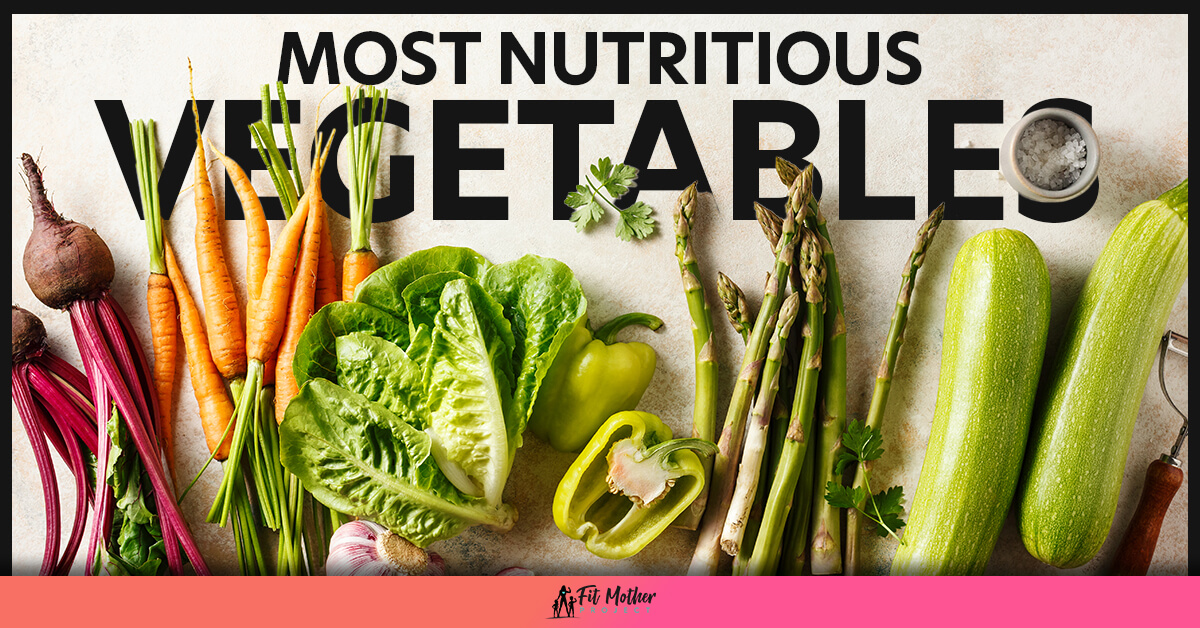You know vegetables are good for you, but which are REALLY good for you? Do you know what the most nutritious vegetables are?
Vegetables are nutritional powerhouses, providing an array of vitamins, minerals, fiber, and phytonutrients essential for maintaining optimal health.
Incorporating a variety of vegetables into your daily meal plan can offer numerous health benefits, ranging from bolstering immune function to reducing the risk of chronic diseases.
Adding a diverse array of nutrient-rich vegetables into your daily meal plan can enhance the flavor and texture of your dishes and provide an abundance of essential vitamins, minerals, and antioxidants crucial for overall health and well-being.
Whether raw, steamed, roasted, or sautéed, vegetables offer endless possibilities for culinary creativity while nourishing your body from within.
So, the next time you plan your meals, make the 10 most nutritious vegetables we lay out below the star of the show for a wholesome and nutritious dining experience.
Learn how to properly portion your meals with the Perfect Plate!
The 10 Most Nutritious Vegetables
Leafy Greens
Leafy greens, such as spinach, Swiss chard, collard greens, and kale, are loaded with vitamins, minerals, antioxidants, and fiber.
They're also very low in calories, containing less than 10 calories per cup. When consumed as part of an overall nutritious eating plan, they are healthy for your heart by improving blood pressure, blood cholesterol, and blood sugar levels.
- Spinach is an excellent source of vitamin A, vitamin K, beta carotene, and lutein.
- Kale is packed with vitamins B, C, A, and K and potassium, copper, and calcium. Check out these delicious kale recipes!
- Swiss chard contains magnesium, manganese, vitamins C, A, and K, as well as antioxidants and plant compounds.
- Collard greens are a good source of calcium, antioxidants, and, of course, fiber!
Sweet Potatoes
Sweet potatoes are starchy vegetables, filling you up for extended periods and giving you energy.
They're also excellent sources of vitamin A, fiber, some protein, beta carotene, potassium, manganese, vitamin C, and vitamin B6.
Peas
Peas are some of the most nutritious vegetables for a unique reason. In addition to being loaded with fiber and micronutrients, peas are a high-protein food, containing 8 grams of protein and 8 grams of fiber in each cup!
Green peas are a good source of vitamins K, A, C, and B. They also contain cancer-fighting plant compounds.
Lentils
Like peas, lentils are also packed with fiber, protein, starch, vitamins, and minerals. They're rich in magnesium, potassium, zinc, iron, copper, manganese, phosphorous, and B vitamins.
And lentils contain nearly 18 grams of protein and 16 grams of fiber in each 1-cup serving!
Red Bell Peppers
While low in calories, red bell peppers are loaded with fiber, vitamin A, and vitamin C. They contain over 100% of your daily value (DV) of vitamin C and nearly half of your DV for vitamin A.
Vitamin A is vital for healthy eyesight, and vitamin C boosts your immune system. Red bell peppers are also a source of potassium, folate, magnesium, and other essential micronutrients.
In just 6-weeks on our FOUNDATIONS Program, you'll transform your health and body, for the rest of your life!Join our 6-Week Program...
You'll Gain Health for Life!
Broccoli
It's likely no surprise that broccoli makes the list of the most nutritious vegetables, as you probably know it is superior to other vegetables in terms of diet and overall health.
Broccoli is a non-starchy vegetable that's low in calories but loaded with cancer-fighting plant compounds, vitamin K, vitamin C, manganese, potassium, and folate.
Beets
Beets are among the most nutritious vegetables for many reasons. This colorful vegetable contains fiber, manganese, folate, copper, potassium, and magnesium.
Beets are also an excellent source of nitrates, substances your body converts to nitric oxide. Nitric oxide helps dilate blood vessels, reduce blood pressure, and promote improvements in athletic performance.
Brussels Sprouts
Brussels sprouts are some of the most nutritious vegetables for various reasons.
They contain disease-fighting antioxidants, plant compounds, fiber, magnesium, potassium, folate, and vitamins K, A, B6, and C.
Red Cabbage
Red cabbage contains more than half of your daily value for vitamin C. It's also rich in vitamin K, fiber, folate, and disease-fighting plant compounds called anthocyanins.
Cabbage is also low in calories, aiding in healthy weight management.
Asparagus
Asparagus completes the list of the most nutritious vegetables. It's low in calories but rich in fiber, folate, vitamin A, vitamin C, potassium, B vitamins, and vitamin K.
It makes the perfect addition to any healthy meal plan for you and your family!
In just 6-weeks on our FOUNDATIONS Program, you'll transform your health and body, for the rest of your life!Join our 6-Week Program...
You'll Gain Health for Life!
Ways to Eat the Most Nutritious Vegetables
Some of the best ways to eat the most nutritious vegetables:
- Grill vegetables
- Sauté vegetables in olive oil
- Steam vegetables and add your favorite seasonings
- Eat veggies in salads topped with oil-based salad dressing (without added sugar)
- Add vegetables to quinoa or pasta dishes
- Add vegetables to soups
- Eat vegetables in stir fry
- Make veggie burgers
- Add sliced vegetables to sandwiches
- Eat veggies in coleslaw
- Pickle your vegetables
- Eat dried veggies
- Add vegetable powder to protein shakes or smoothies
Aim to cook veggies in plant-based oils (or tub butter mixed with plant oil) instead of regular butter.
In just 6-weeks on our FOUNDATIONS Program, you'll transform your health and body, for the rest of your life!Join our 6-Week Program...
You'll Gain Health for Life!
Recipes Containing the Most Nutritious Vegetables
Try the recipes below that enhance the flavor and texture of the most nutritious vegetables!
Oven Roasted Vegetables
Add your favorite vegetables to this flavorful roasted vegetable recipe to increase your menu's fiber and nutritional content!
Ingredients
- 1 medium head of cauliflower
- 1 crown of broccoli
- 1 medium red onion
- 2 medium sweet potatoes
- 1 red pepper
- 1 yellow pepper
- 4 tablespoons of olive oil
- 2 teaspoons of garlic powder
- 2 teaspoons of Old Bay seasoning
- 1 teaspoon of salt
Instructions
- Preheat your oven to 450 degrees Fahrenheit.
- Chop the vegetables into bite-sized pieces.
- Line two baking sheets with parchment paper.
- Spread the vegetables evenly onto each sheet.
- Drizzle the veggies with olive oil and seasonings.
- Mix them with your hands until the vegetables are evenly coated.
- Place the veggies in the oven and bake for 20 minutes.
- Remove the pans from the oven, rotate them, and roast the vegetables for another 10 minutes until tender and lightly browned.
- Place the vegetables in a serving bowl and enjoy!
Servings: 8
Delicious Sauteed Vegetables
Sautéing veggies is another great way to enjoy the most nutritious vegetables!
Ingredients
- 2 red, yellow, or green bell peppers
- 1 medium red onion
- 1 large carrot
- 1 head of broccoli
- 2 tablespoons of olive oil, divided
- 1 teaspoon of dried oregano
- 1/2 teaspoon of salt
- Black pepper to taste
Instructions
- Thinly cut the vegetables into small pieces.
- Toss the vegetables in a bowl with 1 tablespoon olive oil, oregano, salt, and black pepper.
- Heat the remaining 1 tablespoon of olive oil over medium-high heat in a large skillet.
- Cook the vegetables, stirring occasionally, for 10-12 minutes until tender and lightly charred.
- Add additional salt to taste if desired.
- Serve and enjoy!
Servings: 4
Stir Fry Vegetables
Try this stir-fry vegetable recipe with chicken, lean steak, shrimp, tofu, edamame, or cashews!
Ingredients
Vegetables
- 3 heads of broccoli
- 1 medium red onion
- 1 orange bell pepper
- 2 portobello mushroom caps
Sauce
- 3 garlic cloves
- 2 teaspoons of grated ginger
- 2 tablespoons of mirin
- 2 tablespoons of rice vinegar
- 2 tablespoons of soy sauce
- 1 teaspoon of Sriracha hot sauce
- 2 tablespoons of sesame oil
- Salt
- Sesame seeds and green onions for garnish (optional)
Instructions
- Chop the broccoli into large florets.
- Chop the red onion into bite-sized pieces.
- Cut the peppers into bite-sized squares.
- Remove the stems from the mushrooms, slice them into strips, and cut larger pieces in half.
- Place all of the vegetables in a large bowl.
- Mince the garlic, peel and grate the ginger, and place in a small bowl.
- Mix the mirin, rice vinegar, soy sauce, and Sriracha in a small bowl.
- Heat the oil in a large skillet over high heat. Add the broccoli, red onion, bell pepper, and mushrooms.
- Stirring occasionally, cook the mixture for 6-7 minutes until the edges begin to brown.
- Add the garlic and ginger. Cook for 1 more minute until the broccoli turns crisp-tender.
- Turn off the heat and add the sauce. Stir until combined.
- Taste and add additional salt if needed.
- Garnish the mixture with sesame seeds and green onions (optional).
- Serve the veggies with a protein of your choice and rice (optional).
- Enjoy!
Servings: 3-4
Grilled Vegetables
Consider a grilled vegetable recipe during the warmer months to increase the nutritional content of your favorite meals on the grill!
Ingredients
- 2 portabella mushrooms
- 1 eggplant
- 1 zucchini
- 1 yellow squash
- 1 onion
- 1 bunch of thick asparagus
- 1 red bell pepper
- 2 tablespoons of olive oil
- 1 tablespoon of salt
- 1 tablespoon of black pepper
Instructions
- Preheat your grill to medium heat (350-450 degrees Fahrenheit).
- Trim the ends of the eggplant, zucchini, yellow squash, and onion and cut them into 1/3-1/2-inch slices.
- Seed the pepper and cut it into quarters.
- Trim the ends of the asparagus.
- Drizzle the vegetables with olive oil. Sprinkle evenly with salt and pepper.
- Grill the vegetables with the lid closed until they turn tender and lightly charred (about 8-10 minutes for the bell peppers, onion, and mushroom and 5-7 minutes for the yellow squash, zucchini, eggplant, and asparagus).
- Serve and enjoy!
Servings: 4
Erin Coleman is a registered and licensed dietitian with over 15 years of freelance writing experience. She graduated with her Bachelor of Science degree in nutritional science from the University of Wisconsin-Madison, and completed her dietetic internship at Viterbo University in La Crosse, Wisconsin. Prior to beginning her career in medical content writing, Erin worked as Health Educator for the University of Wisconsin-Madison Department of Internal Medicine. Her published work appears on hundreds of health and fitness websites, and she’s currently working on publishing her first book! Erin is a wife, and a Mom to two beautiful children.
Fit Mother Project is the answer you’ve been looking for. Inside the program, you’ll receive: Our Fit Mother 30X Program (FM30X) is the answer you’ve been looking for. Inside FM30X, you’ll receive: The FOUNDATIONS Program is created by Dr. Anthony Balduzzi for Women 40+ who want Lifelong Health. In just 6-Weeks following FOUNDATIONS, you'll experience: FOUNDATIONS has transformed 60,000 lives! Are you ready to experience true lasting health & results?If you’re a busy mom who wants to finally lose weight,
get healthy, and actually keep the pounds off for good,
this is the simple program you’ll love sticking to…
If you’re a busy mom who wants to finally lose weight,
get healthy, and actually keep the pounds off for good,
this is the simple program you’ll love sticking to…
LEARN MORE ABOUT FM30X »

Learn More About FM30X

Join our 6-Week Doctor Designed Health Program.
You'll Gain Foundational Health for the Rest of Life.
*Please know that weight loss results & health changes/improvements vary from individual to individual; you may not achieve similar results. Always consult with your doctor before making health decisions. This is not medical advice – simply very well-researched info on the most nutritious vegetables.


















